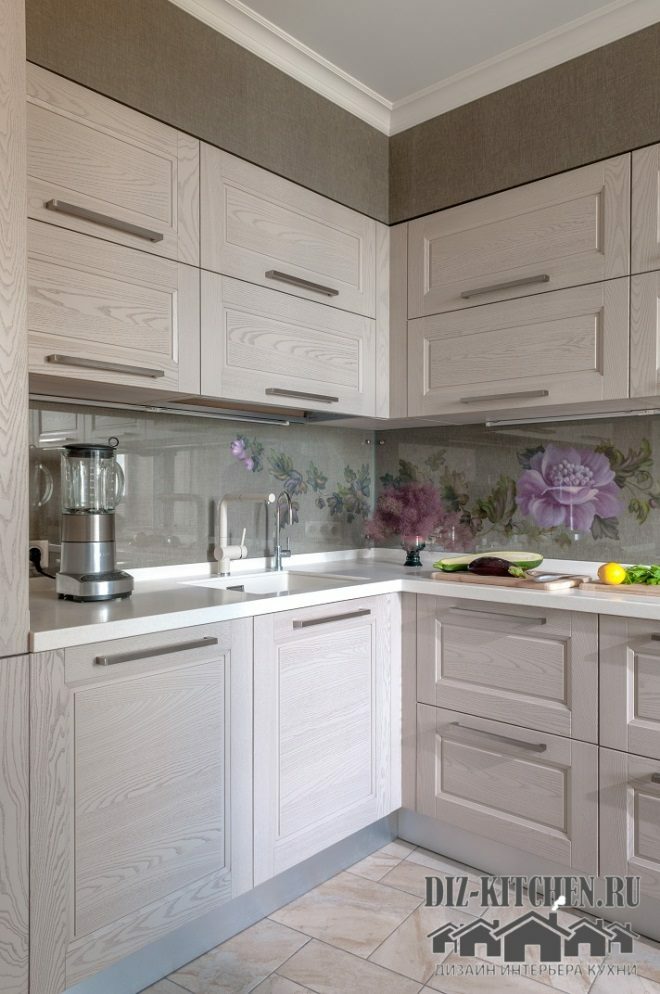The floor in the kitchen should be beautiful, strong, durable, not afraid of water, temperature, pollution. Tiles are most suitable for these requirements. Modern high-quality laminate flooring also copes well with all tasks (except for water resistance). But it is warm and cheaper. Very often they combine tiles and laminate in the kitchen, making the most of their positive qualities.
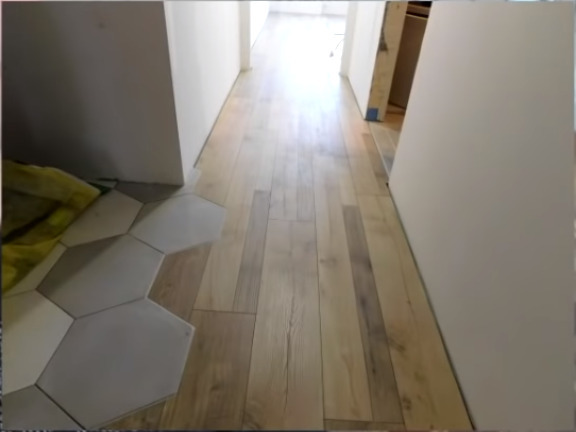
Image taken from https://www.youtube.com/watch? v = Gvm6xeiS5X4
Features of the premises and evaluation criteria
You need to study the properties of each material in order to figure out which is better in the kitchen, tile or laminate. The requirements for the quality of the floor are taken from the characteristics of the room. It can be humid in here due to evaporation of water during cooking. It is often hot and cold. Water or coloring liquids, oil may spill. Also, plates, knives and heavy objects, such as pans, fall.
From here come the evaluation criteria:
Attention! Earned on our website kitchen designer. You can familiarize yourself with it and design your dream kitchen for free! May also come in handy
wardrobes designer.
- Resistance to mechanical stress. For laminates, a wear resistance class of 32 is advised.
- Moisture resistance. In order not to have problems with a swollen floor, buy a moisture-resistant laminate, if financial opportunities allow - waterproof. On the cut of the lamellas, a greenish HDF board is visible, impervious to water.
- It is better to take a laminate with a chamfer, this way the expansion of the material is smoothed out.
- Laminate class E 1 almost does not emit harmful formaldehydes into the air.
- Choose between anti-static and anti-slip laminate flooring for easy cleaning and increased walking safety.
- Tiles are more often used from ceramics, porcelain stoneware, rather than vinyl. The latter is softer, resembles linoleum in appearance, scratches over time and fade in the sun.
- Wear resistance for tiles on the PEI scale is recommended 3 - 4, water absorption class 2, friction coefficient not less than 0.75. AA marking stands for acid and alkali resistance.

Image taken from https://www.youtube.com/watch? v = 1mAxcrvDVik
Comparison of laminate and tile
There is no universal answer to the question of what is best to put on the floor. All kitchens are different in size and style. And for the owners, priorities may differ: one is more important than reliability and durability - put the floor down and forget for 20 - 30 years. Others seek special comfort, a unique atmosphere, and for the sake of it are ready to pay more attention to the care and maintenance of cleanliness.
When choosing what to lay tiles or laminate on the floor, the following qualities will become the advantages of tiles:
- Serves for a long time, rarely breaks (only from falling solid heavy objects).
- Not scratched.
- Absolutely does not deteriorate from water, oil, detergents, odors.
- There are many design options - one- and multi-tone, wood, marble, mosaic, ornaments.
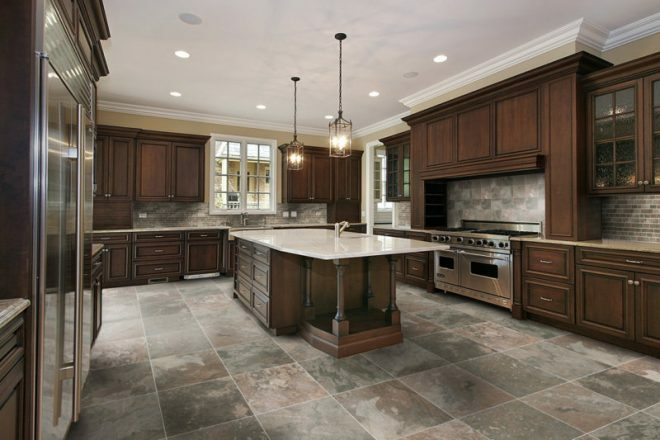
The tile will be a good choice for those who are afraid of water leaks. Especially if such facts have happened before and more than once. And also for those who do not walk barefoot in the kitchen or plan to lay heating in the form of a warm floor. The financial side plays a significant role when choosing a tile: decorating the entire floor with tiles, including the cost of installing it, is quite expensive.
Laminate flooring competes successfully with tiles. According to some indicators, it even wins in comparison with it:
- Both the material itself and its styling are cheaper. However, you should not take the cheapest materials, as they will most likely not be of the best quality.
- Warm to the touch, as they do not conduct heat well.
- Non-slippery material.
- Easy to fit, you can carry out the work yourself.
- All kinds of decor, but most often - under a tree.
- Well dampens sounds from impacts, with proper installation does not creak.
- Dishes break less often.
However, when installing laminate flooring, you need to be prepared to deal with its disadvantages:
- Any liquid on the floor should be wiped off immediately.
- Leave gaps at the edges to compensate for changes in the volume of the material.
- Scratches are more likely to appear, especially where furniture is moved or frequently walked around. Therefore, it is better to close the furniture legs with a cloth and choose a more expensive and stronger laminate.
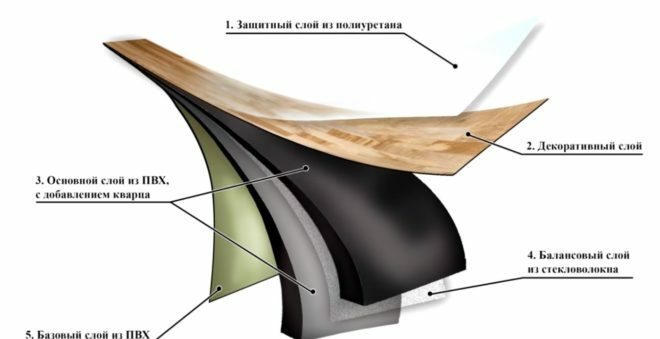
Image taken from https://www.youtube.com/watch? v = bM9p3xzEjUQ
Floor covering requirements
List of requirements for materials that will be laid on the floor in the kitchen:
- Resistant to moisture and spills.
- They must withstand mechanical damage without the formation of abrasions, cracks, scratches.
- Easy to clean during cleaning, do not absorb odors, oil impurities. Detergents can be used without affecting the appearance of the coating.
- Non-flammable, do not emit harmful substances into the air.
There are also a number of requirements. Compliance with them is less critical, but still desirable:
- The floor is not cold and the temperature is pleasant for the feet.
- Not very slippery.
- Should not make loud noises and noise when walking or falling anything.
- Doesn't require frequent renovation or complex maintenance.
- Creates a cozy atmosphere.
In order for the laminate with tiles in the kitchen to serve for a long time, you need to comply with the basic requirements for laying and caring for materials. When buying tiles and laminate flooring, you need to take a little more so that in the event of an accident on the floor there is something to replace the damaged part. The tile breaks more often, and the laminate is damaged by prolonged contact with water, juices, wine, oil.
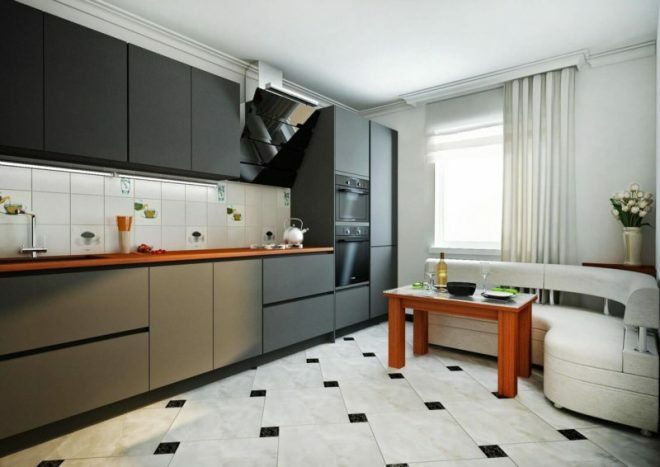
Pros and cons of combined flooring
The advantages of a combined floor in a kitchen made of tiles and laminate are as follows:
- Cost savings.
- Unusual interesting floor decor options.
- The part of the kitchen that is exposed to water will have a more reliable material.
- Facilitates floor care.
- Different materials contribute to the zoning of a large common space, create a different atmosphere in places where they rest and prepare food.
Disadvantages are manifested with an incorrect combination of shape and color, an inconvenient joint line. You should not combine different materials with a small kitchen area - less than 6 square meters.
Combination options for tiles and laminate
The most common combination of laminate and tiles in the kitchen is as follows: tiles are laid near the work surface, stove, sink, and also under furniture. The center of the room, dining area and sitting area are decorated with laminate. So the laminate can be protected from splashes that inevitably appear on kitchen surfaces during cooking or washing dishes.
Ceramic tiles look good in a medium to large kitchen. Small tiles are chosen when decorating a country-style kitchen or a small room. If the tiles with the laminate have approximately the same dimensions, they are laid perpendicular to each other. This emphasizes the division into zones. If the goal is to create the most invisible transition and a single space, choose a parallel type of styling.
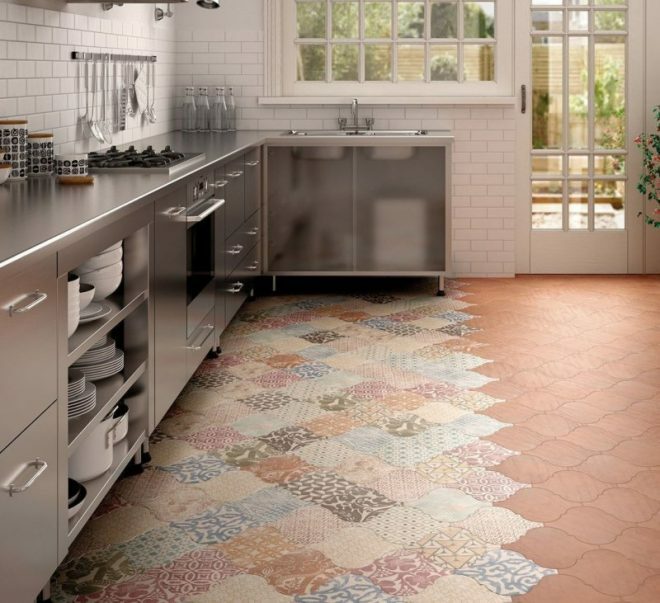
The scheme of dividing the kitchen room with a joint line
If possible, keep the joint line straight and short, this is preferable. It is best to cross the dividing line as little as possible when moving around the kitchen. Since the tile basically corresponds to the working area, its border will most often be L-shaped or straight, depending on the location of the headset.
The transition line on the floor can correspond to the location of the arch or be a continuation of the bar counter, sofa, niche on the border between functional areas.
If the facades or a two-level ceiling have rounded shapes, then it is clear that it is better to repeat the smooth lines on the floor. The curvature of the arc must be selected so that the area of the tiled covering near the sink and refrigerator is maximal, and in the middle of the room most of it goes to the laminate.
Blurred borders can be made using honeycomb tiles.
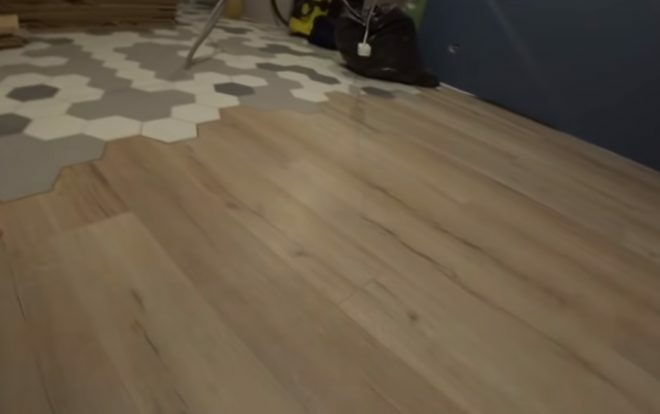
Image taken from https://www.youtube.com/watch? v = pSYlTLP4GN4
Contrasting combination of tiles and laminate
They try to choose the color of the materials in the same range of different tones or use a contrasting combination of tiles and laminate in the kitchen. The tiles are most often made light, and the rest of the floor is dark in color. Laminate is used in brown, reddish or gray tones. Beige, cream, light gray tones are popular for tiles.
Dark tiles are chosen if the facades of the cabinets are light in order to emphasize the furniture. Sometimes, to enhance the contrast, a small podium is made on the border between zones 2 - 3 cm high. This delineates the seating area even more clearly from the rest of the room.
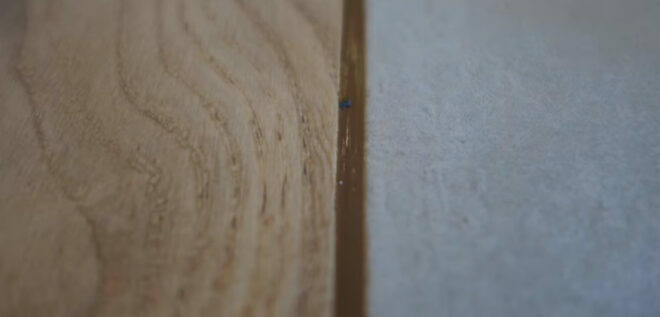
Image taken from https://www.youtube.com/watch? v = eFwvdRqqm0Q
The transition between tiles and laminate in the kitchen
Even before starting the repair, it is important to think over how to make a joint between different materials. It should look harmonious, not interfere with walking, so that people do not cling to and fall through it. Also, liquid should not seep under it and debris should not fall.
There are several fundamentally different ways to design a seam: flush with the floor, in the form of a narrow patch strip or a tangible sill. It is impossible to do without a gap at all, since the laminate must have room for potential expansion in case of contact with moisture. Otherwise, it will quickly swell and deteriorate.
Cork gasket
The cork is a soft and plastic material, it allows you to close the seam flush with the floor. This is one of the popular solutions for combining laminate and tiles in the kitchen. However, it can absorb moisture. The cork tape has wedge-shaped sides. Due to this, the material is tightly held in place by the laminate or tile. The cork is laid simultaneously with the installation of the laminate. The material compensates well for the expansion of the lamellas, does not creak.
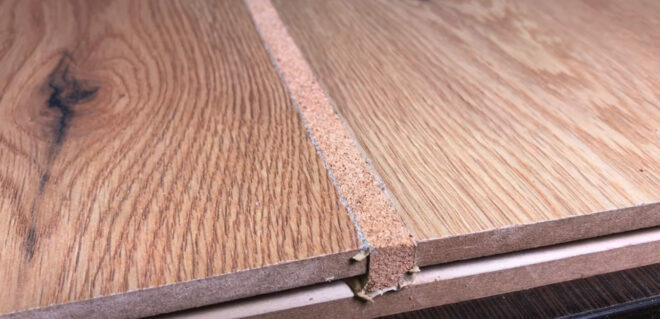
Image taken from https://www.youtube.com/watch? v = Pt6sK9f1FYA
Grouting
The distance between the materials is filled with a PVC tube or a special profile in the shape of the letter G. One part of it is under the tiles, the other rests against the laminated lamellas. From above, the surface is leveled with mastic, silicone.
The floor is flat, without protruding parts. It is convenient and practical. It is advised to use grout of not the lightest tones, otherwise it will quickly darken, the appearance of the floor will deteriorate. You also need to understand that grouting will require periodic renewal. But it does not allow moisture to pass through.
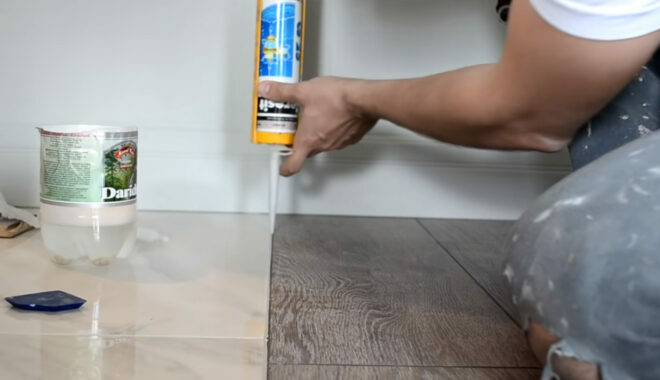
Image taken from https://www.youtube.com/watch? v = r3smosK12cQ
Aluminum nut
Laminate and tile are often joined using an aluminum sill. It can withstand loads well, but debris can clog under it if the joint line is located close to the working area. It is desirable that the joint line runs along the line where people most often walk, and not across it. So it will be less inconvenient. It is also advised to place the nut at a distance of at least 1.5 m from the facades of the kitchen set. When moving around the work area, such an unevenness on the floor will not interfere with the hostess.
The base for the aluminum strip is fixed with dowels, one edge of it goes under the tile. A decorative part is stuffed on top, which resembles the letter T. You can use the rail flush with the floor, then it is painted to match the color of the laminate. Or choose a special profile for the podium.
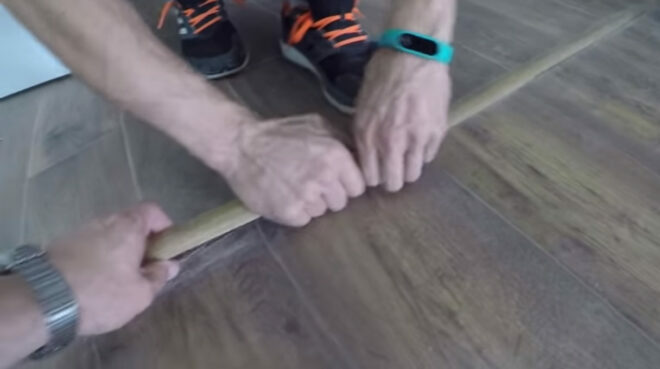
Image taken from https://www.youtube.com/watch? v = eFwvdRqqm0Q
Vinyl nut
Another option for the execution of such a strip is vinyl. It can be used when necessary to make a rounded shape, since aluminum is only suitable for straight lines.
Vinyl planks are produced in different colors, so choosing the right tone is not difficult.
First, the base is attached to the concrete with dowels - a plastic track. Vinyl softened in hot water is placed in it. In the process of cooling, the material quickly sets and keeps its shape well in the future.
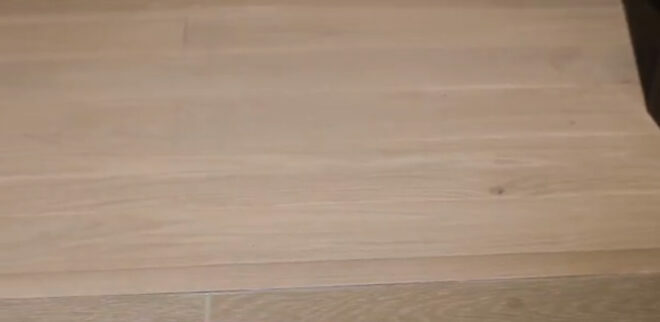
Image taken from https://www.youtube.com/watch? v = MFzQYjg8oTw
Combination rules
The most important rule is that the end result should please the owners of the kitchen, not create difficulties and problems when moving around the room. In practice, many come to this combination: tiles in the work area, laminate - where there will be a dining table with chairs or another seating area. The proportions can be different: from 1: 1 to 1: 3. In small rooms, this can be a strip of tiles along the headset, and the rest of the entire area is laminate. The tile and laminate combination combines comfort in the eating area, relaxation area and the safety against leakage in the work area.
Many agree that lighter tiles look better in the kitchen than laminate. It creates a contrast to the furniture and makes the kitchen more attractive. Although the questions of choosing a design are purely individual and limitless.
Design options
Combining different materials for the floor is allowed if the kitchen is not small. Indoors up to 10 square meters. different materials will clutter up the room and interfere with the overall perception of the kitchen. In medium to particularly spacious rooms, the combination is appropriate and looks good. Great for combined kitchens with living or dining areas. This once again helps to emphasize the different nature of the design of functional areas.
If you want to emphasize the pattern of the floor under a tree, the tiles are selected without a pattern of the same color or contrasting. If the emphasis is on tiles, an ornament is chosen, the laminate should be discreet. Most often, materials of gray or brown colors are suitable for any furniture and walls. You can take black and white, but you will need to monitor the cleanliness more closely. Less often cleaning is required for a floor with a pattern, there are fewer stains and crumbs on it than on a plain laminate or tile.

Image taken from https://www.youtube.com/watch? v = eFwvdRqqm0Q
General recommendations are: with a small area or a dark room, preference is given to light materials, with good natural light and a spacious high kitchen can be laid dark floors. It is also better to combine only warm colors for laminate and tiles or only cold colors without mixing them.
Tiles and laminates are suitable materials for kitchen flooring. You need to show imagination to make the interior attractive, and take into account the technical aspects. Then the floor will turn out to be practical and will serve for many years.
